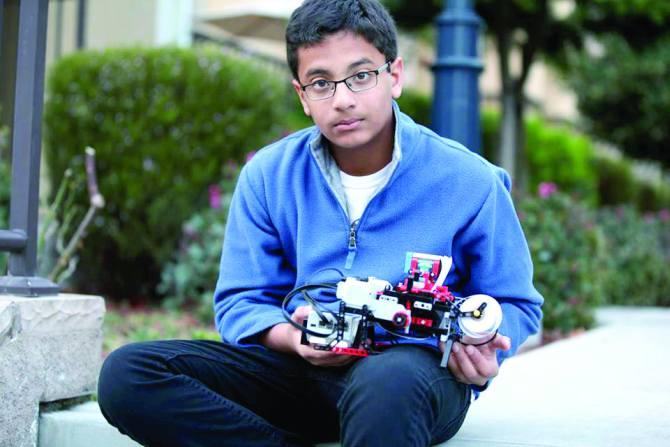Ritu Jha
Shubham Banerjee’s school science fair project has led to the development of a Braille printer prototype that costs one-fifth of what is available in the market today, reports Ritu Jha
Shubham Banerjee could not have imagined the response his ‘Braigo’ -- a low-cost Braille printer he built using Lego blocks (India Abroad, February 28) -- would eventually generate.
“Yes, the response was unexpected,” Shubham, 12, told India Abroad from his home in Santa Clara, California. “What started off as a science fair project could blow up into such a news, I didn’t expect that. My grandparents living in India were able to see me on TV when CNN broadcast the interview!”
According to World Health Organisation reports, 90 per cent of the world’s 285 million visually impaired people live in developing countries.
A basic Braille printer costs $2,000. Shubham’s Braigo cost him $349 to buy the Lego Mindstorms EV3 set and about $5 for some more stuff that went into making the printer.
The story of Shubham’s invention began last December, when among the year-end donation requests his father received was the letter from an organisation that supports blind people.
Shubham asked his parents how visually impaired people read or write. A few Google searches later, he asked his father to buy him a Lego Mindstorms EV3 kit because he wanted to try and build a Braille printer for his science fair at school.
“I had to understand the Braille language by studying online, then I had to create different models and break and again rebuild,” explained Shubham.
“Getting the mechanical motion was the toughest part, but creating the software was comparatively easier. It took me three weeks to build the first prototype. I had to do research and see if it worked.”
Shubham plans to put all the building instructions and the project file online.
“I am creating a Web page to upload the information,” he said. “I will announce it on my Facebook page. I have already started to upload some videos on YouTube. The basic idea is for the development community to further use the concept and maybe make the design and software even better.”
The seventh grader, who was born in Hasselt, Belgium, and came to the United States with his parents as a 3-year-old, hasn’t decided what he wants to be when he grows up.
“I am leaning towards engineering,” he said.
“I was sceptical,” admitted Shubham’s father Niloy ‘Neil’ Banerjee, “but encouraged him since this kit may help him to develop the technology further.”
Asked if any company had contacted them for commercialising the project, Banrejee said, “Yes, Lego and National Instruments have been in contact with Shubham, though it’s too early to mention anything.”



Comment
article